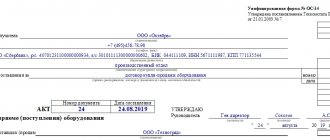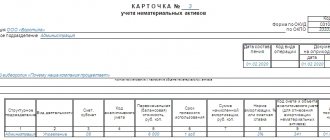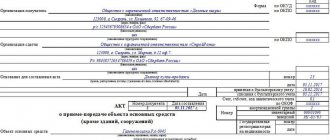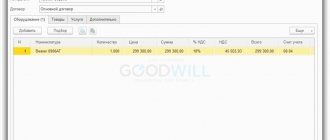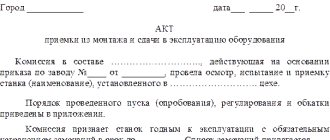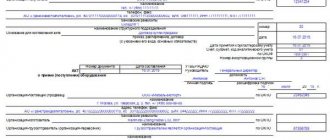Application of the OS-15 act
Depending on what forms the company decides to use (unified or independently developed), it is worth either determining the procedure for filling out independently developed forms, or using the filling instructions approved by Goskomstat. If a company decides to use a unified form, it is necessary to understand some of the features of filling out the act in form OS-15. We will provide a form and a sample of filling out the act at the end of the article.
If the installation of purchased equipment is carried out on its own, then the act is filled out at the time of the actual transfer of the equipment for installation. The act must be completed in two copies. If the installation is carried out by a third-party company under a contract method, the acceptance committee includes a representative of the contract installation organization. There is no need to draw up a separate OS-15 act for transferring equipment for safekeeping: when receiving equipment for storage, an authorized representative of the installation organization signs directly on the act, and a copy of the act is given to him.
Terms of use of form OS-15
Often, situations where the unified OS-15 form is drawn up arise in construction when the customer transfers some technological equipment to the contractor for installation.
Form OS-15 (like most unified forms) has been optional for use since 2013 and can be replaced by another document of similar content. But it contains all the details necessary for such a document and therefore continues to be in demand. The act of transfer of equipment for installation is drawn up in 2 copies, one of which remains with the accountant responsible for accounting for fixed assets, and the second is transferred along with the equipment to the contractor who performs the installation work.
You can see the accounting entries for transferring the OS for installation in ConsultantPlus:
If you do not already have access to this legal system, a full access trial is available for free.
For information on the document documenting the fact that equipment has been accepted into the warehouse, which will then be transferred for installation, read the article “Unified Form No. OS-14 - Form and Sample.”
Act OS-15 (filling sample)
The form for the certificate of transfer of equipment for installation is filled out on both sides of the sheet. In the header of the document, general information is filled in, namely: name of the customer organization, structural unit, OKUD and OKPO form, basis for drawing up the document (name), its number and date of completion. Next, fill in the invoice, sub-account, analytical accounting code, date of delivery of the purchased equipment for installation, date of commissioning of the equipment - the actual date and the date determined by the contract. The document number and date of completion are indicated.
The main part contains general information about the acceptance and transfer of equipment for installation:
- Place of filling out the act, code according to OKPO;
- Name of the manufacturer, OKPO code;
- Name of the supplier company, OKPO code;
- Name of the company performing the installation, OKPO code.
The following contains detailed information about where the equipment was transferred for installation - the exact name of the building and the company's workshop. Information about the transferred equipment is presented in detail in a table consisting of eleven columns:
- Name of the equipment that was transferred for installation;
- Serial number assigned to the purchased equipment;
- Passport or marking number;
- Position number according to the technological diagram;
- Type, brand of equipment purchased;
- The date when the equipment arrived at the customer’s warehouse;
- Acceptance certificate number;
- Number of units of received equipment;
- Cost of one piece of equipment;
- The final (total) cost of the equipment that was purchased;
- Notes.
The reverse side of the OS-15 form contains detailed information about what was discovered during the installation of the equipment. In particular, it is necessary to record whether the equipment corresponds to the design specification or drawing. If the equipment does not comply with the declared parameters, then indicate the discrepancy. Note whether the equipment was received with technical documentation, describe in detail the composition of the kit in which the equipment was received.
Form OS-15 also includes information about equipment defects: if any were discovered, they must be listed. The detailed content and description of defects should be recorded in a separate act on identified defects (form OS-16).
In conclusion, the certificate of transfer of equipment for installation OS-15 contains information about the suitability of the equipment for installation. The act is signed by a representative of the customer company, which handed over the equipment for installation, and a representative of the company carrying out the installation, indicating the position held and a transcript of the signature. Also, the OS-15 act (a sample of the filling below) is signed by the financially responsible person, indicating the position and a transcript of the signature - this confirms the fact that the equipment has been accepted for safekeeping. One copy of the act must be given to the financially responsible person. The date the document was completed is indicated.
Below you can download the unified form of the OS-15 act and see an example of how to fill it out.
Form OS-15 (filling sample)
Often in construction situations arise when the customer company transfers to its contractor some technological equipment for installation at the construction site. Such operations are documented by drawing up acts of acceptance and transfer of equipment for installation in the OS-15 form.
For this act (form OS-15), a standard form has been developed according to the form that was approved by Decree of the State Statistics Committee of Russia dated October 30, 1997 N 71a.
Form OS-15 is drawn up by the customer enterprise in two copies, one of which is sent to the accounting department, and the second copy of form OS-15 is transferred along with the equipment to the contractor enterprise.
The unified OS-15 uniform consists of three parts. The first part is the title part, which reflects the coordinates of the counterparties: the name of the customer organization, supplier, manufacturer and installation contractor. The date and place of drawing up the document, as well as the terms of installation and commissioning under the contract and in fact, are also noted here.
The second part of the OS-15 form is a table that consists of 11 columns: Column 1. Name of equipment. Columns 2, 3 and 4 reflect the numbers: factory (nomenclature) number, passport number and position number according to the technological scheme. Column 5. Type, brand Columns 6, 7 record receipt at the customer's warehouse. Column 6 reflects the date, and column 7 – the number of the acceptance document. Column 8. Quantity in pieces. Column 9. Cost per unit. Column 10. Cost of everything. Column 11 is provided for notes.
The third part of the act in form OS-15 is placed on the reverse side of the form. Here the compliance or non-compliance of the equipment with the design specification or drawing, the completeness or incompleteness of the equipment are noted, and notes are made about possible defects.
If during the transfer of equipment, or during installation, as well as testing, inspection, any defects or damage to the equipment are discovered, then this fact is documented in a report on the detected equipment defects (Form N OS-16). The conclusion of the selection committee on suitability for installation is also noted here.
The act of acceptance and transfer of equipment for installation is endorsed in form OS-15 by three persons: a representative of the customer enterprise, a representative of the contractor enterprise and a financially responsible person responsible for storing the transferred equipment.
Another document that is drawn up when equipment is accepted into the warehouse is the equipment acceptance certificate in form M-15. The act in form M-15 is also drawn up in two copies. To draw up this act in form M-15, a selection committee is formed. If this equipment is to be transferred for installation, then this selection committee includes a representative of the contractor organization that will carry out the installation work. In this case, the representative of the contractor will be given a copy of the equipment acceptance certificate in form M-15.
Cases often arise when it is not possible to thoroughly check equipment for defects. In such cases, the acceptance certificate for M-15 equipment will be considered preliminary, and the inspection itself will be carried out only externally. All defects discovered during equipment acceptance are recorded and documented in a report on identified equipment defects in form M-17.
If this equipment is transferred for installation, which will be carried out by a contractor, then this is the acceptance and transfer of this equipment and will be carried out with the execution of the above-mentioned certificate of acceptance and transfer of equipment for installation in the OS-15 form.
As noted above, these forms OS-15 and M-15 are standard, and therefore, for filling out, they can easily be purchased at printing houses. However, filling out forms OS-15 and M-15 manually is not always convenient. Many modern programs for maintaining estimate documentation already have the ability to automatically output the specified forms OS-15 and M-15 and are deservedly popular among installation and construction organizations for the convenience of document management.
‹ Is it necessary to keep a journal in the KS-6a form?
- Add a comment
How to fill out the tabular part of a document
The columns of the tabular part of the act are filled in as follows:
- 1 – name of special equipment;
- 2 – serial number of the object;
- 3 – equipment passport number;
- 4 – equipment position number according to the technological diagram;
- 5 – type and brand of object;
- 6-7 – date and number of the act on the basis of which the equipment was received at the warehouse;
- 8 – number of objects in pieces;
- 9 – price of one object;
- 10 – total cost of all equipment;
- 11 – column for notes.
Work agreement
Certificate of acceptance and transfer of building materials sample form
The act has two sides.
- On the front page, the name of the customer company is first entered, indicating the OKPO code, as well as the structural unit that accepted the equipment for installation.
- Then the basis for the formation of this document is indicated (here is a link to the agreement with its number and date of preparation).
- Below is the number of the act itself and the date it was written. On the left is the analytical accounting code and the date: the object was handed over for installation and commissioning (as it should be according to the contract and as it actually happened).
- Next, the place of drawing up the act is indicated (not just a locality, as in most documents, but the full address of the enterprise), then the names of the manufacturer, supplier and installation organization are entered (opposite all these lines in the table on the left you need to put their OKPO codes).
- After this, the structural department (workshop, site) that accepted the object for installation is indicated.
Analytical accounting on account 07 is carried out by individual names of equipment (brands, types, etc.), as well as the places of its storage.
Situations when it is necessary to draw up an act of this form mainly arise in the construction industry, when the customer transfers special equipment to the contractor for installation.
Thus, the contract may stipulate that the equipment, the cost of which will subsequently be compensated by the customer, is purchased by the contractor.
Both parties are required to jointly inspect the transferred materials to avoid further disputes.
Equipment is accepted into the warehouse on the basis of an act, form OS-14, the form and sample of which can be downloaded here. After which you can submit it for installation by filling out the OS-15 act.
According to Art. 714 of the Civil Code of the Russian Federation, the contractor is responsible for the failure to preserve the materials provided by the customer, equipment transferred for processing (processing) or other property that came into the possession of the contractor in connection with the execution of the contract. It follows that until the materials received from the customer are written off, the contractor is responsible for them.
The final conclusion on acceptance for installation can indicate that the equipment is suitable for installation and no defects have been identified.
